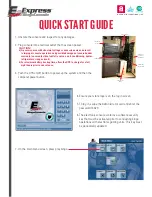
Orion
®
Extra Narrowband
Oxygen-III Imaging Filter, 2"
#5545
The Orion Extra Narrowband Oxygen-III (O-III) Imaging Filter is a line
filter designed for specific imaging applications. The filter transmits
over 90% of the light at the critical O-III wavelength (500.7nm). This
wavelength corresponds with the O-III light emission produced by
certain types of nebulae. When the O-III filter is coupled to an imag-
ing camera and used to image one of these nebulae, contrast will be
greatly increased.
The Oxygen-III filter rejects all visible light with a wavelength below
485nm and above 515nm (FWHM bandwidth approximately 7nm).
Because of this, it should be used only to image nebulae with strong
O-III emission, such as the Dumbell and Veil Nebulas. Broad emission
objects, such as stars and galaxies, will become much dimmer when
the filter is employed.
The extra narrowband O-III imaging filter blocks infrared (IR) and
ultraviolet (UV) wavelength light. The filter has been designed this
way in order to provide the highest transmission of O-III light without
the contaminating effects of IR and UV light, which can reduce image
contrast and lead to bloated star images.
Using the Extra Narrowband Oxygen-III Filter
To use the extra narrowband Oxygen-III filter, you will need a camera
that can accept 2" threaded filters. The filter is compatible with all
Orion StarShoot
™
imaging cameras and most other digital (CCD and
CMOS) astronomical imaging cameras. Simply thread the filter onto
the camera’s 2" barrel until it is finger tight. Then place the camera into
the telescope and bring it into focus as normal.
For digital SLR cameras, you may need to employ a 2" Camera
Adapter to attach the filter. This part is available from Orion. You will
not be able to use the filter with a direct camera T-ring connection to
a telescope.
For most convenient use of the extra narrowband O-III imaging filter,
we recommend the 2" Orion Multiple Filter Wheel or the Nautilus
Motorized Filter Wheel. The filter wheel is especially useful if you wish
to image an object through multiple filters separately. The filter wheel
allows you to quickly change the filter in the light path without the
sometimes frustrating process of removing the imaging system from
the telescope every time a different filter is needed. To use the extra
narrowband O-III imaging filter with the filter wheel, simply thread a
filter into the filter wheel tray as described in the wheel's instruction
manual. You can now switch between filters by rotating the knurled
edge of the wheel. Contact Orion Customer Service/Sales at 800-
676-1343 for details.
When using an extra narrowband filter, a longer exposure is typically
required to obtain enough light to create an image with an adequate
amount of brightness. This is due to the relatively large amount of
light the filter has been designed to block in order to isolate the O-III
wavelength.
Storage and Cleaning
When not in use, the extra narrowband Oxygen-III imaging filter
should be kept in its plas tic case. Given proper care and storage, the
filter will last a lifetime.
Any quality optical lens cleaning tissue and optical lens cleaning fluid
specifically designed for multi-coated optics can be used to clean the
glass surfaces of your filter. Never use regular glass cleaner or clean-
ing fluid designed for eyeglasses.
Before cleaning with fluid and tissue, blow any loose particles off the
surfaces of the filter with a blower bulb or compressed air. Then apply
some cleaning fluid to a tissue, never directly on the optics. Wipe the
lens gently in a circular motion, then remove any excess fluid with a
fresh lens tissue. Oily fingerprints and smudges may be removed using
this method. Use caution; rubbing too hard may cause scratches.
IN 383 Rev A 02/10
Customer Support (800) 676-1343
Email: [email protected]
Corporate Offices (831) 763-7000
89 Hangar Way, Watsonville, CA 95076
Providing Exceptional Consumer Optical Products Since 1975
This graph shows the typical light transmission through the Orion Oxygen-III filter. Note
that the filter only passes visible light with wavelengths between 485nm and 515nm
with a full width half maximum value of approximately 7nm. All other wavelengths
are essentially blocked. Transmission is greatest at 500.7nm, which is the Oxygen-III
emission wavelength.



















